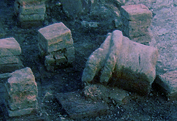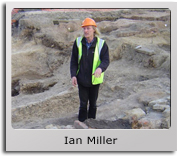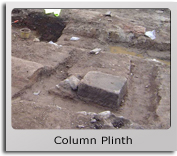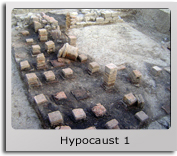
|
 |
||

|
Impressive Remains The next time we saw the site was an evening tour, specially arranged for our society by the excavation project manager, Ian Miller. We started with the obligatory safety procedures and preliminary talk on the site's overall development. This included a mention of the old Ritz Cinema (reputedly once the largest in Europe) which, being considered of no particular architectural merit, was in the throes of being demolished. Ian then led us onto the site to show us just what they had uncovered. Our collective jaws dropped in amazement when he presented us with, not just one hypocaust room but three, together with other rooms including a possible plunge pool. Two of the hypocaust rooms had well defined stoke-holes and the third had smaller rooms off to the west and east. The large stone wall, as indicated by the robbed-out trench, seemed to be aligned with the west wall of one of the hypocaust rooms and proceeded north for another 12 metres before turning east for another 11 metres. It eventually disappeared under Victorian development which had truncated the site on the east side. This represented a huge enclosure but had little or no indication of any internal structure. There was however a room cornered between the enclosure wall and one of the hypocaust rooms. This showed evidence for beam slots which indicated an internal wooden structure or a series of partition walls. Only a small amount of stone survived in the enclosure wall trench but, the little that did, indicated a high quality of construction and, with a general width of 90cm (3 feet), demonstrated a very substantial structure. |
||

|
Colonnade Lying outside the enclosure wall and running parallel to it was another foundation trench, not quite as big but, once again, robbed of its stonework. At the point where it turned the corner, Ian pointed out a huge rectangular block of stone which he initially thought was Victorian because of its fine surface finish. But after further investigations this turned out to be firmly associated with the Roman levels. Its isolated position suggested it was probably a base plinth for a large stone column. Further evidence of similar blocks (one to the south and another to the east) added weight to this interpretation and would probably have represented a portico or maybe colonnaded entrance. The base of a column, found in the one of the hypocaust rooms, may have originated from this feature. |
||
 |
Hypocaust Of the three hypocaust rooms found, the best preserved was the one located to the north and offset to the west of the other two. It had a well defined stoke-hole on its west side which was full of construction debris and burnt material. In the hypocaust room, columns of tiles (or pilae) reached almost one metre high and covered more than 50% of the floor space. The rest of the floor area had been completely cleared by later post-Medieval industrial activity (possibly a bell casting pit). The south wall of this room had been breached by some other industrial activity which had occurred at a later date in the Roman period, probably after the building had gone out of use as a hypocaust. Ian described this as possibly squatter activity, taking advantage of the structural remains. Next |
||